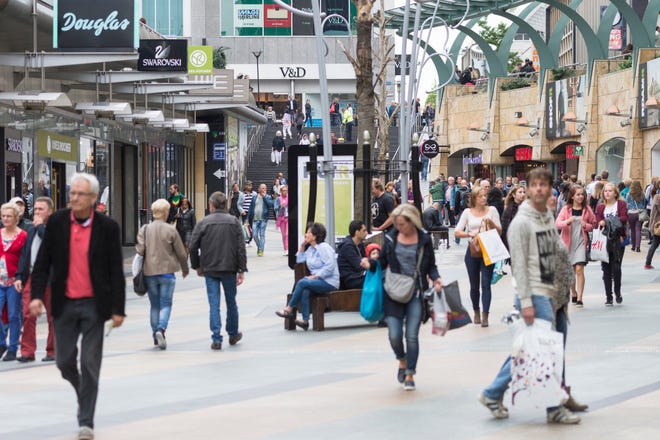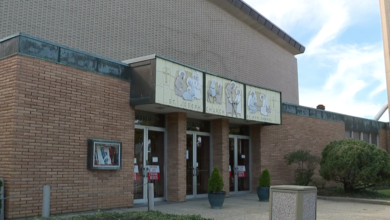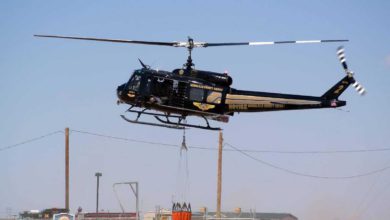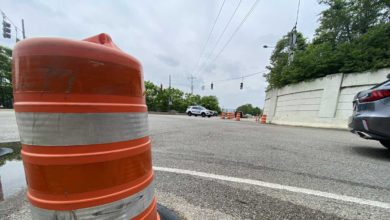
The U.S. economy bounced back sharply in the fourth quarter as consumers splurged again after a summer spike in COVID-19 cases eased and businesses replenished depleted inventories.
The rebound helped the economy turn in its strongest year of growth since 1984 as business reopenings and rising vaccinations unleashed a well of pent-up demand.
The nation’s gross domestic product, the value of all goods and services produced in the U.S., increased at a seasonally adjusted annual rate of 6.9% in the October-December period, the Commerce Department said Thursday. Economists surveyed by Bloomberg had forecast a 5.3% rise in GDP.
The showing followed just a 2.3% advance in the third quarter, when the economy was constrained by the spread of COVID’s delta variant, supply chain bottlenecks, soaring inflation and the fading effects of federal stimulus measures.
For the year, the economy grew 5.7% and generated a record 6.4 million jobs. In 2020, the economy shrank 3.4% and lost 9.4 million jobs as the pandemic shuttered businesses and kept Americans from their normal activities.
But the health crisis made 2021 a volatile comeback year, and that’s expected to continue, at least through the early part of this year.
Consumer spending, which makes up about 70% of economic activity, rose 3.3% the last three months of the year, following a 2% advance the prior quarter. Americans resumed dining out, traveling and other activities early in the quarter after the delta spike abated. Many people also did their holiday shopping early to get ahead of the supply snags.
By the end of the fourth quarter, however, the milder but more contagious omicron variant was leading shoppers to hunker down again. Retail sales fell 1.9% in December. The pullback is likely to hinder economic growth more substantially the first three months of 2022, says Ian Shepherdson, chief economist of Pantheon Macroeconomics.
Delta “caused less disruption both to consumer demand and labor supply,” Shepherdson wrote in a note to clients. He expects the economy to grow at just a 1% annual rate in the current quarter.
Yet with omicron cases falling as quickly as they rose, the economic effects should reverse by February, says economist Paul Ashworth of Capital Economics.
That should set the stage for another solid year of growth in 2022, barring the effects of additional variants. Growth is set to slow to about 4%, the Federal Reserve predicts, as federal financial assistance drops further and consumers deplete their $2.5 trillion in COVID-related savings.
But that would still mark a healthy gain, especially compared to average yearly growth of about 2.2% in the decade before the pandemic.
“The economy is set to face the same problems: a virus that won’t go away, severe supply issues and persistent price pressure,” Wells Fargo economist Sam Bullard wrote in a note to clients.
But all three headwinds should ease through the year, says economist Kathy Bostjancic of Oxford Economics. And continued strong wage growth rooted in persistent labor shortages are likely to fuel strong consumer spending just as a receding health crisis coaxes Americans to resume traveling and other activities.
RATE HIKES RETURN:Fed signals it will likely hike interest rate in March to curtail inflation
PAYING MORE TO BORROW:Your credit card will cost you even more money if interest rates go up. Here's what to do.
How other parts of the economy fared:
Firms beefed up stockpiles
The delta surge intensified the supply chain snarls by keeping many truck drivers and warehouse workers out of the labor force. But the delayed deliveries also led businesses to draw down their stockpiles, a gap they needed to fill by restocking late in the year.
The addition to inventories made up the bulk of last quarter’s growth, adding nearly 5 percentage points.
Business investment picks up modestly
Business capital spending grew just 2% after a 1.7% gain in the third quarter.
Outlays for computers, delivery trucks, factory machines and other accessories edged up 0.8%. Spending on buildings, oil rigs and other structures declined 11.4%. For the second straight quarter, intellectual property spending accounted for the entire increase in business investment, rising 10.6%.
The supply chain problems continued to weigh on equipment outlays, particularly chip shortages that crimped vehicle purchases, Shepherdson says. Rising prices also constrained spending, says economist Andrew Hunter of Capital Economics.
Residential investment edges lower
Housing construction and renovation dipped 0.8% following a 7.7% drop the previous quarter. The industry had been booming the second half of 2020 and early this year. Demand for homes remains strong but the supply chain problems have slowed deliveries of materials and pushed up prices.
The industry also has taken a breather after the surge in construction and renovation earlier in the pandemic as Americans moved to bigger houses in less crowded suburban areas or expanded existing homes.
Trade is neutral for growth
Trade was a wash for GDP growth as exports increased 24.5% while imports rose 17.7%. Previously, a widening trade deficit crimped growth for five straight quarters as U.S. consumer demand bolstered imports while other nations’ recoveries from the pandemic lagged behind the U.S., combibing with the supply problems to hamper exports.
Government spending falls
Government spending fell 2.9% after a 0.9% rise the previous quarter. Federal spending declined 4% while state and local spending dropped 2.2%.

Source link







